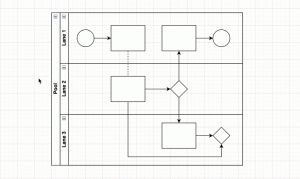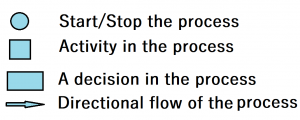What is a swim lane? It seems pretty self explanatory, right? It’s a lane that you swim in. Ok, but what about in the business world? What does it mean then? You can think of it as a visual job description for a particular process. It tells each person, or actor, what actions they are responsible for within that particular process and when they must perform those actions.
Each actor has their own lane, and each lane contains certain symbols that represent an action. It is not the actor that moves from lane to lane. Instead, it is the process that moves throughout the diagram.

In a swim lane diagram, there are many different symbols that describe different events in a business process. But some of the most common ones are: a circle which starts or stops the process, a square which indicates that an action is taking place, a rectangle which tells when a decision must be made, and an arrow which specifies the flow of the process.

Business use swim lanes as a visual to better understand a process. Some of the benefits to using them are that they clearly define each role of an employee in a particular process, they can shed light on potential problems or bottlenecks in a system, and they allow system users to fully understand the entire system outside of their own role. It is for these reasons that swim lanes can be valuable tools in all aspects of business.
Hi Sarah, I really enjoyed reading your explanation of a swim lane. I wonder when we will employ the cylinder symbol for stored data and what we will be using it for. It seems more complicated than the other symbols and their actions but I’m sure it’ll be self-explanatory once we get to that point. I appreciate your including pictures of the symbols and an example of the swim lane. It made your post easy to follow.
Hi Sarah, you did a very good job explaining the idea of a swim lane, and really made it easier to understand for me. The pictures and diagrams you included really backed up your explanation. The most difficult part for me regarding swim lanes is remembering which shapes correlate to which action of the process, and properly constructing them.
Hello Sarah, you explained what a swim lane was in a very concise way. I feel like a lot of the readings we have sometimes overcomplicate what it is they are trying to describe. It’s funny but I really didn’t think of each actor having their own lane in the way which swimmers have their own lane>
Hey Sarah. I really enjoyed reading your post. You described everything fluently and the photo you inserted of the swim lane would be able to accurately teach somebody who did know know what a swim lane was, what it is and how it’s used. When I was writing my blog post I was also wondering when the cylinder will be used because we never incorporated that specific symbol in class or on homework assignments. Overall great job!